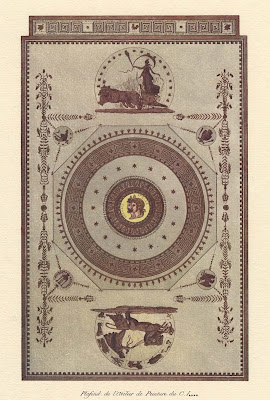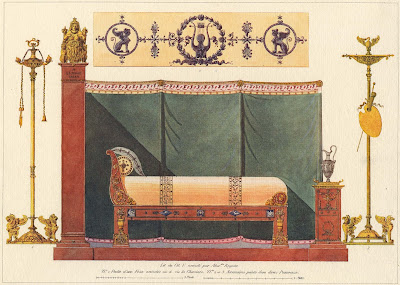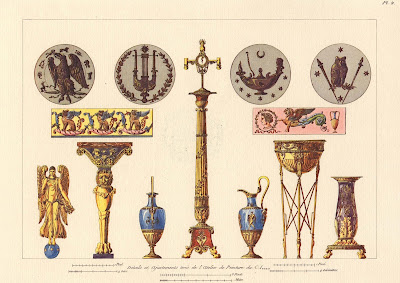














French architects Charles Percier (1764-1838) and Pierre François Léonard Fontaine (1762-1853) first met while attending the Académie des Beaux-Arts in Paris in the early 1780s. Their deep friendship and shared professional tastes were solidified during a subsequent three year sojourn at the French Academy in Rome, where they studied the design styles of classical antiquity.
Back in France they were appointed dual Set Directors for the Paris Opéra - close collaboration throughout their lives makes distinguishing individual contributions to their joint designs virtually impossible. During this period -- the mid-to-late-1790s -- the pair undertook private furniture and architectural design work which brought them to the attention of Josephine de Beauharnais, who engaged their services for the remodelling of the Château de Malmaison, near Paris. So, in turn, were Percier and Fontaine introduced to Josephine's husband, Napoleon, lately returned from a successful campaign in Egypt (introducing further stylistic elements to the pair's developing neoclassical design aesthetic) and busily endeavouring to install himself at the helm of the French government.
Napoleon hired Percier and Fontaine as his official architects and during the next fifteen years their design and redecoration assignments included the Louvre, Tuileries Palace, the Château de Saint-Cloud, palaces at Versailles, Strasbourg and Fountainebleau, the Rue de Rivoli and bridges across the Seine. Their most demonstrable legacy in architectural terms, is undoubtedly the Arc de Triomphe du Carrousel, in the forecourt of the Louvre, and modelled after the Roman Arch of Septimius Severus. The structure was built as a monument to Napoleon's victories and supports the notion that he sought a masculine and military design aesthetic which glorified his reign by association with ancient empires. As to the extent to which Napoleon hoped also to inspire a decorative movement in opposition to the rococo and baroque stylistic excesses favoured by the ousted Ancien Régime - that remains a matter for conjecture.
The interior designs of Percier and Fontaine were particularly influential -
"Their ideas were incorporated and propagated in their Recueil de Décorations Intérieures (1801 and 1812; “Collection of Interior Decoration”). The strong archaeological bias of the Empire style led to direct copying of classical types of furniture and accessories; to this was added a new repertory of Egyptian ornament, stimulated by Napoleon's campaigns in Egypt. Mahogany-veneered furniture with ormolu mounts assumed the shapes of Roman, Greek, and Egyptian chairs and tables with winged-lion supports and pilasters headed with sphinxes, busts, or palm leaves. Where no classical prototypes existed, contemporary designs were enlivened with ancient ornamental motifs, often with symbolic implications in reference to Napoleon's reign e.g., winged victory and the laurel wreath used as decorative symbols of triumph; bees, sheaves of grain, and cornucopias for prosperity; and fasces and sphinxes for conquest."
Building on the formal neoclassicism of the late eighteenth century and championed by Percier and Fontaine's successful pattern books, the Empire Style inspired local adaptations such as Greek and Egyptian revivals and the Regency, Biedermeier and late-Federal styles.
- The hand coloured 1801 version of 'Recueil de Décorations Intérieures' is available in three sections from the Digital Library for the Decorative Arts and Material Culture at the University of Wisconsin (~eighteen plates in total).
- The expanded version of 'Recueil de Décorations Intérieures' from 1812, featuring all seventy two b&w plates is online at NYPL [the b&w image above] {amazingly, the site is not working properly right at the moment: the cache of the first thumbnail page allowed me to see the enlarged images}.
- The image below comes from the book of sketches made by Percier and Fontaine when they were in Rome: 'Palais, Maisons et Autres Édifices Modernes, Dessinés a Rome' was published in 1798 and is available from the Polish Digital Library.
- Charles Percier and Pierre Fontaine at the glbtq culture site.
- The French Ministry of Culture Joconde site provides direct access to a fair number of original sketches by (or inspired by) both Percier and Fontaine.
- I'm not sure if Joconde have all the works from the Graphic Arts Department at the Louvre (search on 'percier et fontaine').
- Percier and Fontaine Collection at The Art Institute of Chicago (mostly just inventory, but the images at the top of the page are viewable)
- Empire Style 1800-1815 at the Metropolitan Museum of Art.
- Empire Style: i, ii, iii, iv, v, vi, vii.
- Saint-Cloud; Malmaison: i, ii, iii; Arc de Triomphe de Carrousel [flickr]
- Just because I found it: 'Paris - Saint Petersbourg 1800-1830. When Russia spoke French'.





















No comments :
Post a Comment
Comments are all moderated so don't waste your time spamming: they will never show up.
If you include ANY links that aren't pertinent to the blog post or discussion they will be deleted and a rash will break out in your underwear.
Also: please play the ball and not the person.
Note: only a member of this blog may post a comment.